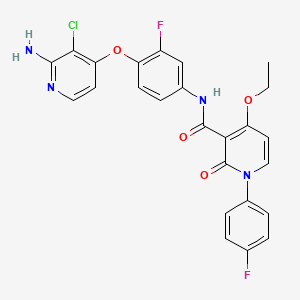Drug Information
Drug (ID: DG01541) and It's Reported Resistant Information
| Name |
BMS-777607
|
||||
|---|---|---|---|---|---|
| Synonyms |
BMS-777607; 1025720-94-8; BMS 777607; 1196681-44-3; BMS777607; ASLAN-002; UNII-A3MMS6HDO1; ASLAN002; N-(4-(2-Amino-3-chloropyridin-4-yloxy)-3-fluorophenyl)-4-ethoxy-1-(4-fluorophenyl)-2-oxo-1,2-dihydropyridine-3-carboxamide; A3MMS6HDO1; N-[4-(2-amino-3-chloropyridin-4-yl)oxy-3-fluorophenyl]-4-ethoxy-1-(4-fluorophenyl)-2-oxopyridine-3-carboxamide; BMS 817378; 3-Pyridinecarboxamide, N-[4-[(2-amino-3-chloro-4-pyridinyl)oxy]-3-fluorophenyl]-4-ethoxy-1-(4-fluorophenyl)-1,2-dihydro-2-oxo-; N-(4-((2-amino-3-chloropyridin-4-yl)oxy)-3-fluorophenyl)-4-ethoxy-1-(4-fluorophenyl)-2-oxo-1,2-dihydropyridine-3-carboxamide; N-[4-[(2-Amino-3-chloropyridin-4-yl)oxy]-3-fluorophenyl]-4-ethoxy-1-(4-fluorophenyl)-2-oxo-1,2-dihydropyridine-3-carboxamide; N-{4-[(2-amino-3-chloropyridin-4-yl)oxy]-3-fluorophenyl}-4-ethoxy-1-(4-fluorophenyl)-2-oxo-1,2-dihydropyridine-3-carboxamide; 3-Pyridinecarboxamide, N-[4-[(2-amino-3-chloro-4-pyridinyl)oxy]-3-fluorophenyl]-4-ethoxy-1-(4-fluorophenyl)-1,2-dihydro-2-oxo-;3-Pyridinecarboxamide, N-[4-[(2-amino-3-chloro-4-pyridinyl)oxy]-3-fluorophenyl]-4-ethoxy-1-(4-fluorophenyl)-1,2-dihydro-2-oxo-; N-(4-((2-amino-3-chloropyridin-4-yl)oxy)-3-fluorophenyl)-4-ethoxy-1-(4-fluorophenyl)-2-oxo-1,2-dihydropyridine-3-carboxamide.; MLS006010958; C25H19ClF2N4O4; CHEMBL460702; GTPL7953; SCHEMBL2588311; BDBM28031; CHEBI:91409; DTXSID50145278; EX-A004; 3f82; HMS3295I07; HMS3655C05; AMY24190; AOB87395; BCP02303; BCP13190; BMS777606; MFCD16495773; NSC764090; NSC799365; s1561; ZINC39716080; AKOS026750587; BCP9000432; CCG-264913; CS-0227; DB12064; EX-7213; NSC-764090; NSC-799365; QC-7244; SB16607; NCGC00263157-01; NCGC00263157-09; AC-30912; AC-31421; AS-17034; DA-35016; HY-12076; N-[4-[(2-Amino-3-chloro-4-pyridinyl)oxy]-3-fluorophenyl]-4-ethoxy-1-(4-fluorophenyl)-1,2-dihydro-2-oxo-3-pyridinecarboxamide; N-{4-[(2-Amino-3-chloro-4-pyridinyl)oxy]-3-fluorophenyl}-4-ethoxy -1-(4-fluorophenyl)-2-oxo-1,2-dihydro-3-pyridinecarboxamide; SMR004702762; BMS-777607;BMS777607; FT-0701277; FT-0722977; SW219298-1; X7495; A25030; BMS-777607, >=98% (HPLC); J-004169; J-523337; BRD-K40738845-001-01-9; Q27075371; N-(4-(2-amino-3-chloropyridin-4-yloxy )-3-fluorophenyl)-4-ethoxy-1-(4-fluorophenyl)-2-oxo-1,2-dihydropyridine-3-carboxamide; N-[4-[(2-Amino-3-chloro-4-pyridinyl)oxy]-3-fluorophenyl]-4-ethoxy-1-(4-fluorophenyl)-1,2-dihydro-2-oxo-3-pyridinecarboxamide,; N-[4-[(2-Amino-3-chloropyridin-4-yl)oxy]-3-fluorophenyl]-4-ethoxy-1-(4-fluorophenyl)-2-oxo-1,2-dihydropyridine-3-carboxamide;BMS-817378;BMS-777607
Click to Show/Hide
|
||||
| Indication |
In total 6 Indication(s)
|
||||
| Structure |

|
||||
| Target | RAC-alpha serine/threonine-protein kinase (AKT1) | AKT1_HUMAN | [1] | ||
| Click to Show/Hide the Molecular Information and External Link(s) of This Drug | |||||
| Formula |
7
|
||||
| IsoSMILES |
CCOC1=C(C(=O)N(C=C1)C2=CC=C(C=C2)F)C(=O)NC3=CC(=C(C=C3)OC4=C(C(=NC=C4)N)Cl)F
|
||||
| InChI |
InChI=1S/C25H19ClF2N4O4/c1-2-35-19-10-12-32(16-6-3-14(27)4-7-16)25(34)21(19)24(33)31-15-5-8-18(17(28)13-15)36-20-9-11-30-23(29)22(20)26/h3-13H,2H2,1H3,(H2,29,30)(H,31,33)
|
||||
| InChIKey |
VNBRGSXVFBYQNN-UHFFFAOYSA-N
|
||||
| PubChem CID | |||||
| ChEBI ID | |||||
| TTD Drug ID | |||||
| DrugBank ID | |||||
Type(s) of Resistant Mechanism of This Drug
Drug Resistance Data Categorized by Their Corresponding Diseases
ICD-02: Benign/in-situ/malignant neoplasm
| Drug Sensitivity Data Categorized by Their Corresponding Mechanisms | ||||
|
|
||||
| Key Molecule: Hepatocyte growth factor receptor (MET) | [1] | |||
| Molecule Alteration | Missense mutation | p.Y1230H (c.3688T>C) |
||
| Sensitive Disease | Solid tumour/cancer [ICD-11: 2A00-2F9Z] | |||
| Experimental Note | Identified from the Human Clinical Data | |||
| In Vitro Model | NIH3T3 cells | Embryo | Homo sapiens (Human) | N.A. |
| In Vivo Model | Athymic female mouse PDX model | Mus musculus | ||
| Experiment for Drug Resistance |
MTS assay | |||
| Mechanism Description | MET mutations Y1248H and D1246N are resistance mechanisms for type I MET-TKIs. NIH3T3 cells expressing either mutation showed resistance to both INC280 and crizotinib but not cabozantinib, indicating the potential of sequential use of MET inhibitors may lead to a more durable response. | |||
| Key Molecule: Hepatocyte growth factor receptor (MET) | [1] | |||
| Molecule Alteration | Missense mutation | p.D1228N (c.3682G>A) |
||
| Sensitive Disease | Solid tumour/cancer [ICD-11: 2A00-2F9Z] | |||
| Experimental Note | Identified from the Human Clinical Data | |||
| In Vitro Model | NIH3T3 cells | Embryo | Homo sapiens (Human) | N.A. |
| In Vivo Model | Athymic female mouse PDX model | Mus musculus | ||
| Experiment for Drug Resistance |
MTS assay | |||
| Mechanism Description | MET mutations Y1248H and D1246N are resistance mechanisms for type I MET-TKIs. NIH3T3 cells expressing either mutation showed resistance to both INC280 and crizotinib but not cabozantinib, indicating the potential of sequential use of MET inhibitors may lead to a more durable response. | |||
References
If you find any error in data or bug in web service, please kindly report it to Dr. Sun and Dr. Zhang.
